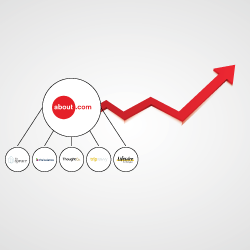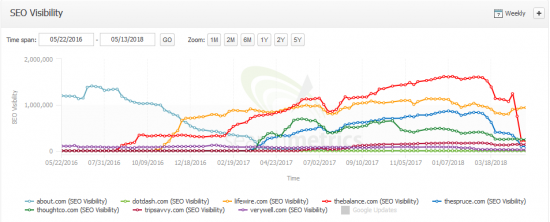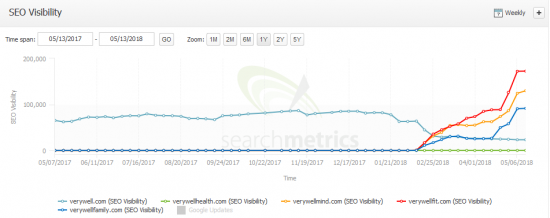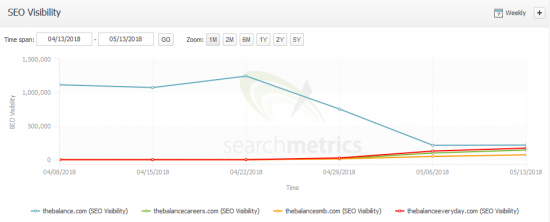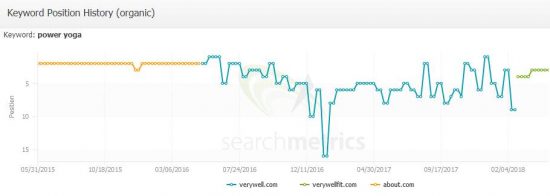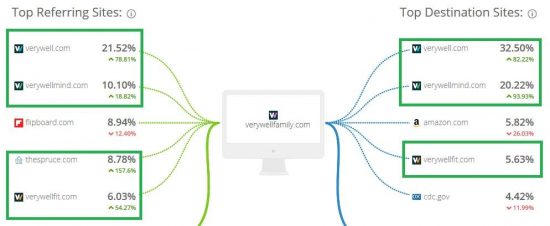Even experienced SEOs are sitting up and taking notice: Is domain splitting the new big thing in SEO? The story of the erstwhile web behemoth about.com is sending shockwaves through the search industry. The portal is splitting itself into new, highly-specific websites – and with astonishing success. In this Unwrapping the Secrets of SEO, we examine whether we are we witnessing the renaissance of niche pages. Could this new trend drive a nail in the coffin for the strategy of online portals trying to be a one-stop-shop for users’ information needs?

Fall and Rise of About.com
For a time, the information giant was one of the most successful websites in the world. At the same time, as a so-called “content farm”, it was more associated with huge-scale mass-production than careful craftsmanship. Beginning with the first Panda Update in 2011, about.com saw its SEO Visibility start to slide. Several years later, the slide had turned into a freefall.
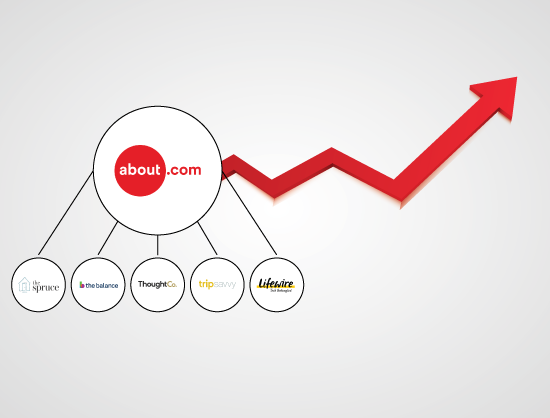
In 2016, about.com yanked the emergency brake, rebranded as DotDash.com and set up a range of special interest domains. With this first domain split , about.com created six new topic sites: LifeWire.com (technology), TripSavvy.com (travel), ThoughtCo.com (education), TheSpruce.com (DIY), VeryWell.com (health) and TheBalance.com (jobs). The chart below shows how well this domain split went; the continual rise of the new topic domains’ SEO Visibility speaks for itself:
In case you’re wondering why the chart shows some domains trending down in recent weeks, we’re getting to that now…
2018: Second-level domain splits
Looking at DotDash’s latest behavior, you could get the impression that some kind of bacteria-style cell division is going on. Since launch: three of the six domains have been split further, clustering the content along even more precise thematic lines.
- VeryWell becomes VeryWellHealth, VeryWellMind, VeryWellFit and VeryWellFamily
The most successful of these second-level domain splits is the segmentation of the health portal VeryWell into four sub-topics: Health, Mind, Fit and Family. Between them, the new niche domains already have more than three times as much SEO Visibility as verywell.com had at its peak in early 2017.
- TheBalance becomes TheBalanceCareers, TheBalanceSMB and TheBalanceEveryDay
In April, the job website TheBalance.com also split, resulting in three more focused domains that deal with careers, small and medium-sized business, and everyday finance tips.
- TheSpruce becomes TheSpruceEats, TheSprucePets and TheSpruce Crafts
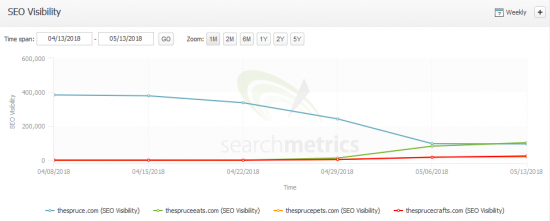 April was a busy month for DotDash, as the DIY portal TheSpruce.com also split into three domains: focusing on recipes, pets and DIY respectively. It’s too early to say whether these latest splits will follow the success of VeryWell.com’s, and how their SEO Visibility will develop over the coming weeks and months.
April was a busy month for DotDash, as the DIY portal TheSpruce.com also split into three domains: focusing on recipes, pets and DIY respectively. It’s too early to say whether these latest splits will follow the success of VeryWell.com’s, and how their SEO Visibility will develop over the coming weeks and months.
The Rise of the Niche
Content that is grouped together thematically performs better than a wild pick-n-mix of different topics. This may not come as much of a surprise – websites that focus on similar topics are better placed to serve user expectations. The clearer the focus is, the more likely it is that the remit fulfills users’ wishes and demands around that topic. With this in mind, Searchmetrics has, for some time now, been conducting analyses that focus on a specific industry or smaller niche topic.
Three Observations on Domain Splitting
1. Clean execution minimizes losses
One highly impressive feature of the domain splits is how smoothly they have been executed. This has not only helped SEO Visibility get back to – and exceed – its pre-split heights, but rankings for individual keywords have also quickly recovered.
2. Domain splits create a referral universe
Another interesting observation is how traffic flows between the individual pages. DotDash has created a platform universe, within which users can quickly find their way to other relevant URLs, potentially reducing the rate of Back-to-SERP clicks. This, in turn, sends improved user signals from the DotDash Universe back to Google. To demonstrate, the following graphic shows how traffic flows between domains, coming in and out of VeryWellFamily.com. (Data from SimilarWeb.)
3. Niche pages are making a comeback
About.com hasn’t been the only online “one-stop-shop” to see its performance suffer. Competitors like ehow.com and general Q&A portals have also experienced steady declines over the past years. What we’re seeing now is niche pages making a comeback: Comprehensive content on as many landing pages as necessary to cover a topic as holistically as possible – that’s how to build up a reputation and how to excite users and Google.
Conclusion
The remarkable success of about.com, which divided millions of URLs into new, topic-specific portals, reveals several SEO trends. Malte Landwehr, Director of Product Marketing & Solutions at Searchmetrics, gives his take on the about.com story:
All-purpose portals are dead. A network of high-quality special interest pages is the key to success for online editorial content. Unfortunately, the majority of publishers are yet to wake up to this trend.
We will continue to follow developments and time will tell whether about.com’s successful strategy establishes itself across the industry as a long-term SEO trend.
